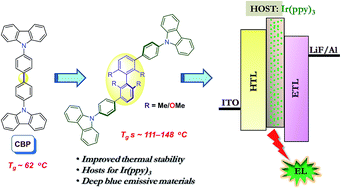Twisted biaryl-amines as novel host materials for green-emissive phosphorescent organic light-emitting diodes (PhOLEDs)†
Abstract
Insertion of rigid biaryl moieties, namely, 2,2′,6,6′-tetramethylbiphenyl and 2,2′,6,6′-tetramethoxylbiphenyl, between two phenyl rings of CBP leads to novel host materials with improved thermal stabilities (Tgs ∼ 111–148 °C). Their high triplet energies (2.63–2.83 eV) permit application as host materials for green phosphors, i.e., Ir(ppy)3. External quantum efficiency and brightness of the order of ca. 15% and ca. 6000 cd m−2 have been realized with TetMeTPA and TetOMeCZL, respectively.


 Please wait while we load your content...
Please wait while we load your content...